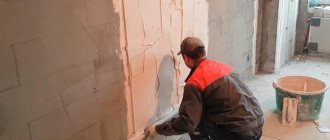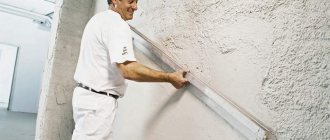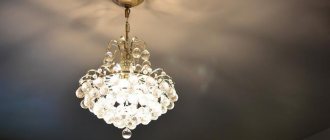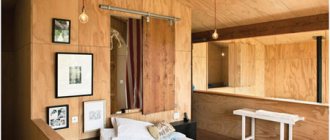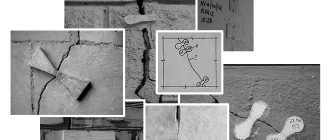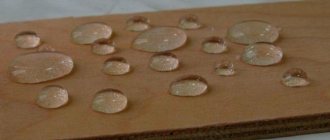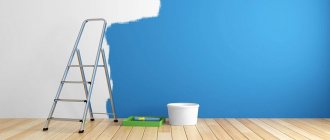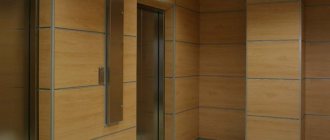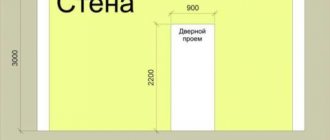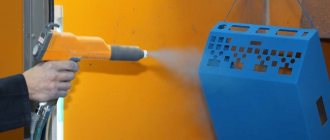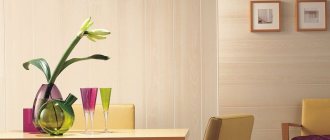22692 0 16
Michel October 22, 2016Specialization: plumber with 10 years of experience, computer repair specialist, powerlifting coach. I have extensive experience in construction, interior decoration, and making homemade furniture. Hobbies: sports
This article is devoted to methods for installing partitions and leveling walls with gypsum-based sheet materials. In it I will talk about the methods used for fastening them and what can be used as lathing and frames for finishing. Since all, without exception, methods of fastening gypsum fiber boards and gypsum plasterboard are identical, we will talk about both materials.
GVL sheathing of insulated walls of a frame house.
Types of GVL depending on the area of application
There are products intended only for dry rooms; another type is not destroyed by water and is used in damp conditions.
The stable layer does not react to ultraviolet radiation and does not interact with chemical ingredients in the atmosphere. Depending on this, two types of sheets :
- GVL - ordinary, without moisture-proof qualities;
- GVLV - resists the absorption and accumulation of water.
The latter option is installed in industrial workshops without surface finishing with ceramic tiles, since the layer is not destroyed for a long time by steam and moisture, and treatment with detergents is allowed.
Depending on the size, there are small-sized and standard slabs . The first type of fiber panels is installed in rooms with complex layouts, on figured facades, to reduce the amount of trimming.
Gypsum fiber boards - types and advantages of the material
There are two types of gypsum fiber sheets (GVL), the difference between them lies in the manufacturing method and properties. Some are suitable for rooms with high humidity, while others cover other walls. Moisture-resistant sheets (GVLV) have impregnations that protect products from water and steam. Their area of application is unheated rooms, bathrooms, kitchens. Non-moisture resistant GVL are used in dry rooms.
The basis of the boards is gypsum - a rather brittle material, therefore, to increase strength, cellulose and reinforcing additives are additionally used in production. GVL for walls differs from plasterboard: during its production there is no cardboard covering. The strength of gypsum plasterboard is much greater than that of drywall. In many cases, gypsum fiber boards are simply irreplaceable when finishing walls, especially in unheated rooms. They do not lose their properties when subjected to repeated freezing and defrosting.
Among other advantages of GVL, increased fire resistance is noted. Covering wooden walls with gypsum fiber boards increases their fire safety. The material contains no impurities harmful to human health. Fungi and mold do not find a nutrient medium in them, and rodents are also not interested in them. The products are very durable, warm to the touch, insulate sounds well, and protect against heat loss.
GVL comes in standard and small format sizes. Standard 2500×1200 mm, 10 or 12 mm thick. Small format ones are made 1500x1000 mm of the same thickness. They are convenient in small spaces: bathroom, toilet. On the reverse side there is a marking indicating the properties of the product. The letter A in the marking indicates high quality.
These products are supplied to the market by many enterprises producing building materials. You should choose products from well-known manufacturers. Visual inspection will also help you get an idea of the product. The surface must be undamaged and free from unevenness. You should buy from stores that have dry warehouses where the goods have been stored under proper conditions.
Among other advantages of gypsum fiber boards, the following should be noted:
- construction defects and communications are hidden under them;
- pressed sheets are very strong and tough, nails and screws are securely attached to them;
- the material can be processed with carpentry tools like wood;
- the surface is painted, wallpapered, tiled.
Gypsum fiber boards
GVL can be used in any premises, regardless of the condition of the surfaces or the material used.
This is an alternative to wet plaster: environmentally friendly, durable, beautiful, requiring a minimum of time and effort during installation.
Features of fastening gypsum fiber board to the wall
Installation is similar to installing simple drywall, but there are some features to pay attention to.
two ways to attach GVL to the wall :
- using a frame or lathing;
- frameless method.
Wiring, water and sewer pipes, and air conditioning system ducts are laid inside between the slats. The frame is used to install insulation, waterproofing film, and sound insulation.
If such insulating layers are not required, finishing without a frame is used, and the sheets are glued to the treated and leveled surface of the walls.
On the frame
Metal profiles with a galvanized layer
are used elements from the plasterboard fastening system are more often used. The slats are fixed to the wall with dowels, and self-tapping screws can be attached to the wood. You can use a wooden beam , having previously soaked it with drying oil.
Use profile types :
- CD-60 is used for vertical posts, transverse stiffeners;
- UD-25 is installed around the perimeter of the frame, the ends of CD-60 are inserted into its body;
- ES bracket or hanger is used to level the supporting profile in the plane; lengths of 90, 120, 150, 200 mm are used.
To form the frame, a level and plumb line are used to control verticality and horizontality. The plane is aligned along the stretched cords to avoid distortions.
Directly to the wall
The frameless method of installing gypsum fiber board on a wall involves carefully leveling the wall using plaster. Rigid sheets cannot bend over an uneven surface; they crack if they are pulled with hardware.
Rules for using glue:
- for unevenness up to 4 mm a gypsum composition , and the mass is spread over the entire surface, or applied in separate dots or stripes;
- if the unevenness does not exceed 2 cm, then use special glue , it is applied in strips;
- PVA is used for gluing slabs without a frame when laying a floor base on a concrete layer.
You can attach sheets to beacons , without leveling the entire surface, but only placing the elements in a single plane.
Installation of gvl on walls with your own hands video
One of the most common problems encountered when performing finishing and installation work on ceilings and walls is alignment. Modern construction technologies have recently made great strides, making available a multitude of ways to efficiently and quickly level any, even the most stubborn, surfaces. Today, consumers have access to a wide selection of various mixtures that allow them to level walls with their own hands, without requiring complex tools or special skills.
Every year, if not month, new types of finishing materials appear on the construction markets, but the old, good and reliable GVL was and remains the most practical and reliable way to both level walls and build partitions and ceilings. Today I would like to talk in more detail about installing gypsum fiber sheets with my own hands.
When working with gypsum fiber sheets, there are two main types of installation: framed and frameless. The advantage of the second method is that after finishing the cladding, the walls do not require special processing and finishing. Do-it-yourself frameless installation of gypsum fiber boards is carried out without the use of a frame, when the sheets are glued directly to the wall. This type of installation is less labor-intensive than frame installation, however, it requires more accurate measurements and calculations. In addition, frameless installation of gypsum fiber boards is more preferable in small areas.
In this case, a frame is first erected, which can be made of either wooden blocks or a metal profile. The second option is the most common, we will talk about it in detail.
Before installing the frame structure, the walls require preliminary preparation. Since there remains a void between the sheets and the wall, it is logical to assume that unwanted organisms, from fungi to all kinds of insects, can appear in these voids. To avoid such problems in the future, the walls should be treated with an antiseptic primer before constructing the metal frame. As for materials, you will need the following:
- Guide metal profile;
- Profile for installation of GVL;
- Direct hangers;
- If the design is complex, then crabs are used for attaching stiffeners;
- Dowel-nails;
- Self-tapping screws;
- Appropriate tool.
By and large, installing a frame from a metal profile with your own hands will not be difficult. First of all, guides are attached along the perimeter of the wall.
They must be leveled accordingly. The quality of the entire structure will entirely depend on how you installed them. So-called dowel nails are used as fasteners. Each guide element has holes provided for this purpose. We apply the guide profile to the wall in accordance with the level, then drill a hole in the wall with a hammer drill, drive a dowel-nail through the hole in the profile, thereby securely fixing it to the wall.
Guides and dowel-nail photo
According to the technology, the distance between the fastening elements should not exceed fifty centimeters, but the more often, the more reliable it is.
Distance between fasteners photo
Further, after installing the guide elements of the structure, a metal profile is attached to them accordingly. The upper part is cut to size and connected using rivets (as shown in the photo).
We connect it to the wall with straight hangers; the distance between the elements is more appropriate - thirty centimeters. Thus, a sheet of gypsum fiber, which has a standard width of about twenty meters, will be fixed on four profiles. This will allow, as they say, “not to play with the structure”, not to vibrate and be less susceptible to external influences.
Direct suspension photo Distance between elements 30 cm. photo
However, there are walls that have holes, potholes, significant differences in level, and so on. In such cases, it simply won’t be possible to secure the profile under the gypsum plasterboard with your own hands on direct hangers, or it will be an outright “hack job”, in this case we use a little trick, which is as follows: From the guide element we make a corner (as shown in the photo) and actually on we install it.
We cut a piece of the guide profile photo Bend it at a right angle and attach it to the wall with dowel nails photo
After the frame is ready, we proceed to the installation of gypsum fiber boards. Actually, installing gypsum fiber boards with your own hands on a ready-made frame is not difficult. The only inconvenience is that the sheet is heavy and tall, with standard dimensions of 10x1200x2500 millimeters, the GVL sheet weighs approximately 36-37 kilograms, as a result of which it will be very inconvenient to install it with your own hands alone; an assistant will be required.
As for the installation itself, it goes like this: naturally, the first step is to measure the height from floor to ceiling. As mentioned above, a standard sheet has a length of two meters and fifty centimeters, this is the standard height of a residential apartment, but if you take into account the flooring, etc., you will still have to trim it. GVL is cut with a regular wood hacksaw. It is necessary to take into account that it becomes dull instantly, therefore it is advisable to take an unnecessary tool for this purpose. Also, many people use an angle grinder with a diamond blade, but when working with it, a large amount of dust is generated, which is not only difficult to remove, but also requires breathing.
After everything is measured, we proceed directly to the installation of gypsum fiber boards. We install the sheet and use a screwdriver to secure it to the profiles. According to standards, the fastener spacing should not exceed fifteen centimeters. As a rule, the bit on the screwdriver is magnetized; we simply put a self-tapping screw on it and screw it to the profile through the GVL. There is no point in making holes (as some do), everything will be fixed well without them. The only caveat is that the caps of the screws need to be well sunk into the sheet, otherwise there will be problems with further finishing.
To complete the installation of gypsum fiber boards with your own hands, you should prepare the surface for subsequent finishing, that is, level it. Pay attention to the cut of the sheet, they have indentations. It is these recesses in the joints, as well as the heads of the screws, that need to be puttied, which is why it was said that the heads need to be recessed well.
To prevent cracks from subsequently forming at the joints, there is a special reinforced tape “reinforced tape”, it is made exactly to the size of the recesses at the joints and has a self-adhesive surface. We lay it at the joint, putty, also putty where the screws are screwed in, wait until it dries, clean it with fine sandpaper - it's done.
Thus, today we looked step by step at how to install gypsum fiber sheets (GVL) with our own hands using the example of a wall. As you can see, there is nothing complicated about this and the whole work resembles a game of children's construction sets. That's all for me, I wish you success, goodbye.
However, it is not always applicable. GVL is suitable exclusively for interior work. It is too fragile and susceptible to the vagaries of the environment, which means it will not be possible to level the outer walls.
Finishing rooms with gypsum fiber sheets has many advantages, which is explained by the excellent characteristics of the material. GVL slabs for walls have a number of parameters that distinguish them from similar types of products. Installation of products can be carried out using several methods and is not particularly difficult, but has some nuances.
GVL is mistakenly put on the same level as drywall, since the materials have different technical characteristics. Main product advantages:
- Strength. This figure is achieved due to the composition of the product: in addition to gypsum, which occupies 80%, the boards contain cellulose fibers - about 20%. This structure allows it to withstand serious mechanical loads and makes it possible to hang interior items on a vertical surface without fear of deformation of the base.
- Moisture resistance. Gypsum fiber board has two main varieties: regular gypsum fiber boards and special ones - GVLV. It is the second option that is used in rooms with high humidity: bathrooms, corridors, kitchens, loggias. But standard products are also moisture resistant enough to be placed in utility areas with unstable humidity.
- Frost resistance. Using this material, it is possible to cladding walls in unheated rooms. The resulting coating can withstand up to 14–16 cycles of freezing and thawing without loss of strength.
- Heat and sound insulation. Gypsum fiber prevents the penetration of extraneous noise and significantly reduces audibility in adjacent rooms. Also, the use of products helps to increase the energy efficiency of a house or apartment.
- Easy to install. You can cover the walls entirely with your own hands; this does not require special skills or complex equipment.
- Fire safety. The boards are suitable for installation in rooms with a high risk of fire and evacuation corridors.
Gypsum fiber sheets are aimed at creating durable partitions and coverings, while plasterboard is more suitable for constructing decorative multi-level structures.
These indicators are characteristic only of high-quality material that has all the necessary certificates of conformity. That is why when choosing products you should give preference to trusted manufacturers.
The dimensions of gypsum fiber boards are reflected in the relevant regulatory documents; a special GOST R number 51829-2001 has been developed for this type of product. Sheets are usually divided into two main categories: small format and standard. The first option is used mainly for laying on horizontal bases, while the second is excellent for walls.
For work with vertical structures, the following dimensions are used:
- width –120 cm;
- length – 250, 270 and 300 cm;
- thickness - 10 and 12.5 mm, in special cases it is possible to use panels of 15 mm or more.
For the construction of partitions and finishing of residential premises, sheets with a thickness of 12.5 mm are considered the most popular.
Some manufacturers can produce products of other sizes while maintaining the basic parameters.
On a note! When choosing, also pay attention to the edge: it can be straight or chamfered. The second variety is preferable, but it is much less common and has a high cost.
Interior work involves two main methods of fixing slabs, each of which has its own characteristics and is suitable for a specific situation.
This method is used for attaching gypsum fiber boards to foundations that have significant flaws and unevenness. The sheathing can be constructed from wooden beams or metal profiles; the choice of material depends on the type of surface. If the walls are concrete or brick, preference is given to a more reliable metal frame. For a wooden base, timber is better suited, but it must be thoroughly dried and treated with protective agents, so this method is used much less frequently.
For installing gypsum fiber boards on walls, the frame method is more preferable. This is explained by the fact that the resulting structure is suitable for additional insulation and hiding communications.
To mount the guides correctly, the following technology is used:
- The process begins after correcting the defects of the base: it is cleared of unnecessary objects and old coating, which may interfere with the work or become deformed in the future. It is also necessary to seal the cracks.
- The main work begins with marking. To finish a room with GVL, a standard profile pitch is selected - 55–60 cm. For an accurate calculation, the size of the insulation is taken into account in order to eliminate unnecessary trimming.
- The installation follows the same pattern as the installation of drywall. The upper and lower guides are set first using a plumb line. Next, the vertical posts are mounted on hangers, placed depending on the condition of the base in increments of 30 to 45 cm.
- Jumpers are laid between the racks.
The sheathing for sheathing with gypsum fiber board and gypsum board sheets is mounted in exactly the same way.
It is necessary to achieve the utmost rigidity and reliability of the resulting structure. To do this, the elements are attached to the wall with dowels, and all parts are connected to each other with metal screws.
You can install gypsum fiber products on the sheathing according to the following instructions:
- Installation can be carried out from the corner or from the middle. The appropriate method is selected taking into account the size of the slabs, as well as the presence and location of window and door openings.
- If required, insulation is first laid and communications are laid.
During installation, the sheets are installed in such a way that the joint falls exactly in the middle of the sheathing post
- The sheets are placed with a gap from the ceiling and floor. Also, a 3–5 mm joint is formed between the parts to compensate for possible shrinkage of the building.
- Fastening is carried out using self-tapping screws in increments of 15–25 cm. The screw head should be recessed flush to prevent complete puttying in the future, if this is not required by the type of finishing.
To fasten gypsum boards to a metal sheathing, only metal self-tapping screws are used; sheets can be fastened to a wooden beam with any screws, but it is cheaper to mount them with wood screws
. may be processed.Attention! Screwing in self-tapping screws will require more effort than when laying drywall, so choose an electric screwdriver or drill for the job. Nails can be used instead of screws, but only when creating wooden sheathing.
The arrangement of partitions is carried out according to the same scheme as the finishing of walls, only wall profiles are used for lathing, and insulation is laid in the internal cavitiesThe frameless method allows you to level the surface much faster, but is used much less frequently, since it assumes the absence of serious deformations of the base (differences should not exceed 3–4 mm).
You can attach GVL to glue according to the following scheme:
- The slabs are mounted directly to the wall only after preliminary preparation: it is necessary to completely eliminate small defects and cracks. You should also clean the surface of the old decorative layer, which will not allow the gypsum fiber to be reliably glued.
A special glue is selected for the procedure. It is not recommended to use unsuitable formulations; in this case, the result cannot be predicted. The mixture is applied to the wrong side of the material, after which the part is pressed tightly and leveled. Due to the need to form a gap from the floor and ceiling, a gasket is laid underneath.
- The remaining elements are glued according to the same pattern.
Using gypsum plaster boards mounted on glue, you can quickly level walls with slight curvatures; this method is also called dry plastering.
In exceptional situations, it is possible to use gypsum plasterboard to level out more significant differences - up to 3-4 cm. In this case, gypsum fiber should be fixed using a combined method : glue onto the putty mixture with additional fixation with self-tapping screws. The composition is applied pointwise or linearly to ensure the alignment of the sheets in relation to each other without the formation of sagging points. Screws are used to align and secure parts together.
For installation of gypsum fiber finishing, only special compounds should be used, and for dry rooms, gypsum glue is used, and for wet rooms, universal glue is used.
Refinement of the resulting surface can be carried out in various ways, but always after preliminary preparation:
- The joints between adjacent panels are sealed. To do this, the seam is treated with a primer and filled with elastic putty. If work is carried out in a recently erected building, then the areas are strengthened with reinforcing tape. This will avoid the formation of cracks in the future.
- The seams are rubbed down to level out possible unevenness.
- The surface is completely covered with primer and dried well.
All joints between sheets must be primed, after which they are reinforced with serpyanka and puttied with compounds with increased elasticity.
You should know! It is rarely necessary to putty GVL, so further work is carried out much faster.
Decorative finishing is selected depending on the specific situation:
GVL is an excellent option for walls, as it provides a durable and reliable base that can be lined with various materials.
Front Side Definition
Finding the wrong side is the first step when installing sheets on walls. For moisture-resistant models, both sides contain a moisture-proof layer, but the panels must be laid correctly - facing outward. GVL is produced with a rough (unpolished) surface, the other side is polished.
There are chamfers on the front sides of the panels to putty the joints of the sheets, and there are markings on the surface for self-tapping screws.
Valera
The voice of the construction guru
Ask a Question
The reverse side is different in that the material is marked on it. If there is no letter and number designation, the sheets may be fake. The characteristics of such panels may differ, moisture resistance may be reduced, and the strength does not correspond to the declared value.
Method 1: Using polyurethane foam
The range of polyurethane foam is wide, and therefore you can choose a cylinder not only with suitable contents, but also of the right size
Polyurethane foam is a foamed polyurethane sealant enclosed under high pressure in an aerosol package. Foam, when applied to various surfaces, demonstrates a high degree of adhesion. When in contact with air, the foam polymerizes, hardening and increasing in volume.
The photo shows a universal cylinder cap; it can be used with or without a mounting gun.
Advantages of gluing on foam:
- Small price for the finished result . On average, 1 can of foam is enough to install 6 standard plasterboard slabs.
- Possibility of installation without filling the sheathing . The standard installation of gypsum fiber boards is carried out on a wooden or metal sheathing and this increases the cost of the finished result and at the same time consumes the free space in the room.
- Possibility of gluing on walls with a large difference in levels , since the foam during polymerization increases in volume and completely fills the relief.
- Natural heat and sound insulation. With proper installation, sealed cells are formed in the gap between the gypsum plasterboard and the wall and, as a result, effective heat and noise insulation.
- Sheathing strength. Polyurethane foam after polymerization provides high tear strength. Therefore, the casing does not even have to be additionally reinforced with self-tapping screws.
Disadvantage of sticking to foam:
- Foam instability before polymerization. Within 10-15 minutes the polyurethane foam is unstable. Therefore, drywall without support will slide off.
- Polyurethane foam is soft after polymerization. Therefore, installation in this way is recommended only on walls where the sheathing does not bear excessive loads.
Wall gluing technology
| Illustrations | Installation instructions |
| Surface preparation . We apply a flat strip to the wall or other mounting plane and check the depth of the gaps. |
The advantage of foam is that it can be glued to uneven surfaces, but it is advisable to install it on a relief of no more than 10 mm. That is, if the differences are very large, they can be sealed with a cement-sand mixture or putty.
When screwing the screws into the sheet of drywall, apply a spirit level and make sure that the corners of the sheet are located in the same plane and do not warp.
Gap between sheets
The vertical gaps between the plates are left at 5 - 7 mm, with a gap of 5 mm up to the ceiling, and 8 - 12 mm in the area where they join the floor. Profile racks are installed at a distance of 603 mm from each other (for fastening g/cardboard - 600 mm) in order to maintain the possibility of organizing such a gap between the gypsum fiber board sheets.
Types of edges:
- PC - straight shape of the side edges of the sheet;
- FC is a folded type.
The seams are glued with reinforcing mesh , it is better to use fiberglass. It is fixed with a special compound for embedding moisture-resistant material, for example, Uniflot, Fugen. The screws around the perimeter of the panels are twisted in increments of 25 - 30 mm, extending from the edge at least 10 mm.
Characteristics and properties of drywall adhesive
If you use the method of fixing gypsum boards with self-tapping screws, then this method has the following advantages:
- reliability of design;
- durability.
If you choose the second method, there are the following advantages:
- Minimum investment of time and effort. There is no need to first level the walls or make detailed drawings indicating where the screws will be fixed.
- Economy. There is no need to spend money on screws, fasteners, or profiles.
- The dimensions of the room remain almost the same. No distance is wasted on installing the frame.
Installing drywall on an adhesive base simplifies many aspects.
Drywall can be glued using the following compounds:
- Perlfix plasterboard adhesive is a waterproof composition, so it is widely used in gluing plasterboard to walls in different rooms. This could be a kitchen, loggia, attic, bathroom. Knauf PerlFix contains synthetic fibers, so the consumption of drywall adhesive is minimal. The complete drying time for the finished solution is 7 days, but if you follow the temperature conditions specified in the instructions, the period is reduced to 5 days. The price of the mixture is 245 rubles.
- Elastic adhesive Polymin for drywall. A dry mixture that doesn’t take much time to prepare. It perfectly fixes drywall to the wall. They can be used to seal seams between sheets of drywall. It has reinforcing properties. Its component is gypsum. When working with glue, it is necessary to observe the temperature regime. Price for 1 bag containing 25 kg 180 rub.
- Gypsum mixture "Volma". It has a plastic composition. This glue fixes not only drywall, but also other elements, for example, polystyrene foam or insulation. The glue does not shrink after a while. It is moisture resistant, so it can be used in the bathroom and on the balcony. Price 173 rub. for 1 bag (25 kg).
- Fugenfüller putties. This type of putty is used after installing plasterboard sheets for laying tiles on it. The putty is applied using the spot method, which keeps costs to a minimum. The adhesive is used in rooms with high humidity and has the ability to protect the surface from fungus and mold. Price 250 rub. for 1 bag containing 25 kg.
- Sealant. The construction market is filled with various types of sealants: silicone, acrylic, polyurethane, combined, bitumen. Silicone sealant is the more common type. It is water-repellent and transparent. Even though it has a pungent odor due to its constituent substances, it performs its functions perfectly. This glue is used to process the gaps between plasterboard sheets or between tiles being laid. This glue is suitable for gluing wallpaper on plasterboard walls and laying tiles. Price 156 rub. for 1 cylinder.
- Foam. Using polyurethane foam, you can attach drywall in two ways. The first method: use self-tapping screws and fill the void with foam. Second method: direct use of foam. In order to apply method 2, you should consider some facts:
- weight of a sheet of drywall;
- effectiveness of assembly adhesive;
- thermal conditions of the room, humidity level.
Types of fasteners
The sheets are fixed to the sheathing with special screws designed for working with gypsum fiber boards.
They are attached so that they enter at an angle of 90°, and are recessed into the profile by at least 10 mm. The heads are recessed 2 mm into the body of the panel. Types of glue for frameless GVL installation technology:
- On a gypsum basis. Standard solution for fiber sheets. It is sold in the form of a dry mixture, which is mixed with water before use. The composition contains lime, gypsum, plasticizers, and strength additives.
- Based on cement binder. Such compositions are intended for tiles, but hold well on 12.5 mm thick fiber panels. Used in rooms where there are damp walls, for example, on the first floor, in the basement.
For the glue method, you need to prime the surface .
How else can you decorate the walls in an apartment? Methods of modern interior finishing: GVL and LSU
GVL are gypsum fiber sheets that perform the same function as gypsum plasterboard, but are more durable and, unfortunately, more expensive than plasterboard. The density of gypsum fiber sheets is quite high, which must be taken into account when transporting them. When the sheets are moved from place to place, they must be unfolded perpendicular to the ground. Installation of gypsum fiber sheets is carried out using special self-tapping screws.
GVL can only be cut using a jigsaw or a saw with large teeth. The sheets must be attached to a mounting profile with a thickness of at least 0.8 mm, otherwise the screws will not be able to be embedded in the gypsum plasterboard and subsequent finishing will be difficult. Puttying is carried out similarly to working with drywall.
SML is glass-magnesite sheets used for interior wall decoration; they appeared on the finishing materials market quite recently, but have already become popular among consumers involved in leveling vertical surfaces. This material has even been hailed as the finish of the future. At first glance, LSU really has many advantages - lightness, moisture resistance, strength, non-flammability. The material contains environmentally friendly components magnesite, bischofite and perlite. In addition, the sheets are odorless and do not emit harmful fumes, and do not deform when exposed to high temperatures.
It is also important that this modern material for interior wall decoration is not susceptible to fungus and mold. The surface of LSU is glossy white, so there is no need for puttying, and the cost of the material is quite comparable to plasterboard sheets
But LSU also has its disadvantages. The density of the sheets is less than that of gypsum plasterboard, which means that the looseness of the material can cause breakage of the sheets during transportation and their deformation when stored in a vertical position
Carelessness during installation can lead to destruction of the edge of the sheet, and during operation it can become deformed at the points of attachment to the frame.
GVL and SML are widely used not only for leveling walls, but also for flooring before laying linoleum and laminate. LSUs are also successfully used in outdoor work. Thus, it is clear how widespread the use of gypsum plasterboard, gypsum fiber board and SML is in finishing works associated with obtaining even and smooth surfaces without the use of plaster.
Surface finishing
A wall finished with GVL or GVLV sheets is primed with deeply penetrating compounds to increase adhesion for subsequent finishing.
Topcoat options:
- improved putty for painting, application of paint and varnish composition;
- wallpaper putty, roll material sticker;
- finishing with ceramic tiles, tiles;
- sticking cork, making decorative plaster;
- finishing with MDF panels, plastic, natural wood, stone.
Gypsum fiber boards go well with any finish, so they provide a variety of options. There is no need to level the surface, so work time is saved and material consumption is reduced.
How to make a partition from gypsum fiber board
With the help of GVL you can create your own apartment design. After all, it won’t be difficult to make partitions from gypsum fiber. The frame made of guides and rack profiles is no different for gypsum plasterboard and gypsum board. Accurate dimensions and reliable fastening to the floor and ceiling are required. You will need sealing tape at all joints.
Galvanized screws are suitable for fastening; the approximate distance between them is 1 m. Before installation, the profiles must be cut to the required length and installed according to the markings. Holes are punched out through the profiles using a hammer drill, and dowels are installed. And now only screws remain.
To attach sheets to the partition, you need sheets of gypsum fiber with a chamfer. The folded edge of GVL is the processed edges of sheets. Do not forget about gaps of about a centimeter. When the sheets are already in place on one side, you need to soundproof them with any materials suitable for these purposes. And secure the sheets on the other side.
